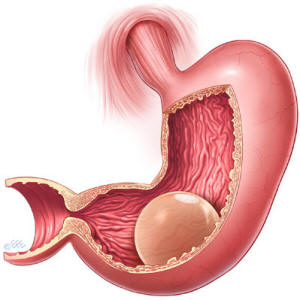The price for the installation of the intragastric balloon – from 60,000 rubles
The insertion into the stomach of a silicone balloon, developed in 1986, is the least invasive operation in bariatric surgery.
Its positive aspects are the ease of procedure, the minimum number of contraindications, the low complication rate, and the attainment of weight loss without any significant effort on the part of the patient.
Intragastric balloon explanation
Intragastric balloon is a silicone vessel, round in shape, filled with a liquid or with air. The walls of the container are designed to stay in the stomach for 6 months. The balloon is inserted into the stomach in the course of endoscopic survey, by means of a special delivery device. For the convenience of passing through the oral cavity and the larynx, the balloon is compactly folded into a tube of about 1.5 cm in diameter. Upon the introduction of the balloon into the stomach, it is inflated by means of a special syringe with air or liquid to the volume of 500-700 ml. After that, the balloon valve is closed and the delivery device removed from the stomach. In the case of filling the balloon with a liquid, it is done with a solution of methylene blue tinting, which allows to control the balloon in the event of depressurization. After 6 months, the balloon must be extracted.
While the balloon is inserted, it is necessary to take medical drugs reducing the secretion of the stomach (Omeprazole, Pantoprazole, etc.).
Indications for the use of intragastric balloon.
* The balloon can be inserted in all patients with a
BMI in excess of 30 kg / m2.
* As a treatment method applied in addition to diet therapy.
* In preparation of patients with severe forms of obesity for surgical treatment. The balloon is used in order to maximize weight loss before the upcoming surgery. It can significantly reduce anesthesiological and surgical risks.
Contraindications to installing the balloon
* The presence of inflammatory diseases of the gastrointestinal tract, including esophagitis, gastric and duodenal ulcer, Crohn’s disease, malignant stomach tumors.
* The presence of large hiatal hernias, potential sources of bleeding in the gastrointestinal tract (esophageal varices and gastric telangiectasia). Also in the presence of congenital anomalies of the gastrointestinal tract (atresia and stenosis), strictures and diverticula of the pharynx and esophagus.
* The installation of the balloon in the stomach is contraindicated in the presence of medical problems that may make it difficult to perform fibrogastroscopy.
* Likewise contraindicated to the balloon insertion is the presence of mental disorders, alcohol and drug abuse.
* Contraindications include a constant use of aspirin, other anti-inflammatory drugs, steroids, drugs that irritate the stomach, as well as anticoagulants (drugs that lower blood clotting).
* Pregnancy and breastfeeding are also contraindicated.
How is the weight reduced by intragastric balloon
On insertion of the intragastric balloon, the volume of the stomach is significantly reduced, due to the volume occupied by the balloon. Accordingly, if an average meal amounts to about 500 ml, the intake of 80-100 ml of food will induce satiety .
This amount of food will be optimal for an effective weight loss. But we should not forget about the calory content of various products, since a mere 100 ml of certain foods (chocolate, cream, butter, etc.) may contains large amounts of energy. This also applies to liquids consumed. Water can be drunk without restrictions, but this does not go for sweetened beverages ( juice, fruit nectar, etc.), as 100 ml of such drink contains about 45 calories. If you gulp down a 1-liter pack of such beverage every day, you get a daily total of 500 kcal, which makes up one third of the calorie intake required to reduce weight. Gradually, the stomach will adjust to the balloon and the amount of food intake will decrease. It is important that at this stage to eat until the feeling of satiety is reached. In such a case the stomach will not be stretched by large amounts of food and at the end of a 6 month-period a good result will be obtained from the treatment.
Body weight is decreasing most rapidly during the first 1.5 – 2 months, and then it is slowing down. The average weight loss on completion of the treatment is up to 30% of excess body weight.
What should be done after removing the balloon?
On removing the intragastric balloon, the habit of eating small portions of food is retained. Preserving such a diet will now depend solely on the patient’s motivation, since there are no more restrictions in the stomach. The most dangerous possibility upon the removal of the balloon is to engage in a festival of “empty stomach”, wherefore in just a few weeks the amount of nourishment will be reinstated to its former grand scale, and, correspondingly, the lost weight regained.
Mention should be made here that, upon removal of the balloon within the prescribed time, the body mass may increase if the patient does not follow the recommended diet.
If the patient has managed to adjust to the new diet, s/he can save the achieved level of weight loss, and even improve it. Therefore, take your time before you go to a restaurant, cafe, or to a friendly tableful, just keep your diet.
The above contemplated method is intended for short-term use in patients with moderate to severe obesity in cases of inefficient conservative therapy, as well as for preliminary weight loss before surgery in patients with severe obesity.
